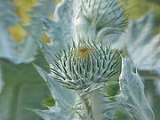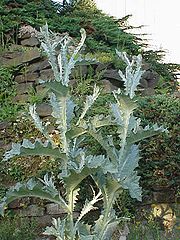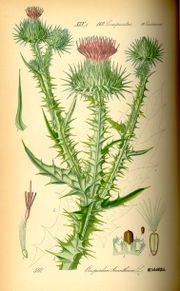
Onopordum
Encyclopedia
Onopordum L.
is a genus of about 40 species of thistle
s belonging to the family Asteraceae
, native to Europe
(mainly the Mediterranean region), northern Africa
, the Canary Islands
, the Caucasus
, and southwest and central Asia
. They grow on disturbed land, roadsides, arable land and pastures.
They are biennials
(rarely short-lived perennials
) with branched, spinose winged stems
, growing 0.5-3 m tall. In the first season they form a basal rosette of gray-green felted leaves
and rarely a few flower
heads. In the second season they grow rapidly to their final height, flowering extensively, and then die off after seed maturation.
The leaves are dentate or shallowly lobed to compound with several pinnatifid or deeply cut leaflets, and strongly spiny
.
The terminal flower head is typical for thistles, a semi-spherical to ovoid capitulum
with purple (seldom white or pink) disc florets. There are no ray florets. The receptacle is glabrous with dentate margins. The tube of the corolla is slender, sac-shaped and symmetrical. The anthers have awl-shaped outgrowths on the top. The capitula have several overlapping rows of leathery basal simple linear-lanceolate spines. These are smooth to slightly pubescent.
These plants propagate only by seed
. The seed heads mature in mid-summer, releasing their seeds. The fruit
is a glabrous achene
, 4-6 mm long and with 4-50 ribs. The pappus consists of many rows of simple, fine to minutely rough hairs, united in a circular base.
Onopordum species are used as food plants by the larva
e of some Lepidoptera
species including Coleophora onopordiella
(feeds exclusively on O. acanthium).
In the Greek
island of Crete
a native species called agriagginara (αγριαγγινάρα) or koufoti (κουφωτοί) has its heads (flowers) and tender leaves eaten raw by the locals.
Selected species
Natural hybrids
s in the temperate regions of North America
and Australia
, where they have become naturalised in the wild. In most of these countries, these thistles are considered noxious weed
s, especially in Australia where a biological control program has been set up (using the Rosette Crown Weevil
, Trichosirocalus briesei). In North America, there are also Trichosirocalus control programs, but they have proved detrimental to native thistles.
Carolus Linnaeus
Carl Linnaeus , also known after his ennoblement as , was a Swedish botanist, physician, and zoologist, who laid the foundations for the modern scheme of binomial nomenclature. He is known as the father of modern taxonomy, and is also considered one of the fathers of modern ecology...
is a genus of about 40 species of thistle
Thistle
Thistle is the common name of a group of flowering plants characterised by leaves with sharp prickles on the margins, mostly in the family Asteraceae. Prickles often occur all over the plant – on surfaces such as those of the stem and flat parts of leaves. These are an adaptation that protects the...
s belonging to the family Asteraceae
Asteraceae
The Asteraceae or Compositae , is an exceedingly large and widespread family of vascular plants. The group has more than 22,750 currently accepted species, spread across 1620 genera and 12 subfamilies...
, native to Europe
Europe
Europe is, by convention, one of the world's seven continents. Comprising the westernmost peninsula of Eurasia, Europe is generally 'divided' from Asia to its east by the watershed divides of the Ural and Caucasus Mountains, the Ural River, the Caspian and Black Seas, and the waterways connecting...
(mainly the Mediterranean region), northern Africa
Africa
Africa is the world's second largest and second most populous continent, after Asia. At about 30.2 million km² including adjacent islands, it covers 6% of the Earth's total surface area and 20.4% of the total land area...
, the Canary Islands
Canary Islands
The Canary Islands , also known as the Canaries , is a Spanish archipelago located just off the northwest coast of mainland Africa, 100 km west of the border between Morocco and the Western Sahara. The Canaries are a Spanish autonomous community and an outermost region of the European Union...
, the Caucasus
Caucasus
The Caucasus, also Caucas or Caucasia , is a geopolitical region at the border of Europe and Asia, and situated between the Black and the Caspian sea...
, and southwest and central Asia
Asia
Asia is the world's largest and most populous continent, located primarily in the eastern and northern hemispheres. It covers 8.7% of the Earth's total surface area and with approximately 3.879 billion people, it hosts 60% of the world's current human population...
. They grow on disturbed land, roadsides, arable land and pastures.
They are biennials
Biennial plant
A biennial plant is a flowering plant that takes two years to complete its biological lifecycle. In the first year the plant grows leaves, stems, and roots , then it enters a period of dormancy over the colder months. Usually the stem remains very short and the leaves are low to the ground, forming...
(rarely short-lived perennials
Perennial plant
A perennial plant or simply perennial is a plant that lives for more than two years. The term is often used to differentiate a plant from shorter lived annuals and biennials. The term is sometimes misused by commercial gardeners or horticulturalists to describe only herbaceous perennials...
) with branched, spinose winged stems
Plant stem
A stem is one of two main structural axes of a vascular plant. The stem is normally divided into nodes and internodes, the nodes hold buds which grow into one or more leaves, inflorescence , conifer cones, roots, other stems etc. The internodes distance one node from another...
, growing 0.5-3 m tall. In the first season they form a basal rosette of gray-green felted leaves
Leaf
A leaf is an organ of a vascular plant, as defined in botanical terms, and in particular in plant morphology. Foliage is a mass noun that refers to leaves as a feature of plants....
and rarely a few flower
Flower
A flower, sometimes known as a bloom or blossom, is the reproductive structure found in flowering plants . The biological function of a flower is to effect reproduction, usually by providing a mechanism for the union of sperm with eggs...
heads. In the second season they grow rapidly to their final height, flowering extensively, and then die off after seed maturation.
The leaves are dentate or shallowly lobed to compound with several pinnatifid or deeply cut leaflets, and strongly spiny
Thorns, spines, and prickles
In botanical morphology, thorns, spines, and prickles are hard structures with sharp, or at least pointed, ends. In spite of this common feature, they differ in their growth and development on the plant; they are modified versions of different plant organs, stems, stipules, leaf veins, or hairs...
.
The terminal flower head is typical for thistles, a semi-spherical to ovoid capitulum
Inflorescence
An inflorescence is a group or cluster of flowers arranged on a stem that is composed of a main branch or a complicated arrangement of branches. Strictly, it is the part of the shoot of seed plants where flowers are formed and which is accordingly modified...
with purple (seldom white or pink) disc florets. There are no ray florets. The receptacle is glabrous with dentate margins. The tube of the corolla is slender, sac-shaped and symmetrical. The anthers have awl-shaped outgrowths on the top. The capitula have several overlapping rows of leathery basal simple linear-lanceolate spines. These are smooth to slightly pubescent.
These plants propagate only by seed
Seed
A seed is a small embryonic plant enclosed in a covering called the seed coat, usually with some stored food. It is the product of the ripened ovule of gymnosperm and angiosperm plants which occurs after fertilization and some growth within the mother plant...
. The seed heads mature in mid-summer, releasing their seeds. The fruit
Fruit
In broad terms, a fruit is a structure of a plant that contains its seeds.The term has different meanings dependent on context. In non-technical usage, such as food preparation, fruit normally means the fleshy seed-associated structures of certain plants that are sweet and edible in the raw state,...
is a glabrous achene
Achene
An achene is a type of simple dry fruit produced by many species of flowering plants. Achenes are monocarpellate and indehiscent...
, 4-6 mm long and with 4-50 ribs. The pappus consists of many rows of simple, fine to minutely rough hairs, united in a circular base.
Onopordum species are used as food plants by the larva
Larva
A larva is a distinct juvenile form many animals undergo before metamorphosis into adults. Animals with indirect development such as insects, amphibians, or cnidarians typically have a larval phase of their life cycle...
e of some Lepidoptera
Lepidoptera
Lepidoptera is a large order of insects that includes moths and butterflies . It is one of the most widespread and widely recognizable insect orders in the world, encompassing moths and the three superfamilies of butterflies, skipper butterflies, and moth-butterflies...
species including Coleophora onopordiella
Coleophora
Coleophora is a very large genus of moths of the family Coleophoridae. It contains some 1,350 described species. The genus is represented on all continents, but the majority are found in the Nearctic and Palaearctic regions...
(feeds exclusively on O. acanthium).
In the Greek
Greece
Greece , officially the Hellenic Republic , and historically Hellas or the Republic of Greece in English, is a country in southeastern Europe....
island of Crete
Crete
Crete is the largest and most populous of the Greek islands, the fifth largest island in the Mediterranean Sea, and one of the thirteen administrative regions of Greece. It forms a significant part of the economy and cultural heritage of Greece while retaining its own local cultural traits...
a native species called agriagginara (αγριαγγινάρα) or koufoti (κουφωτοί) has its heads (flowers) and tender leaves eaten raw by the locals.
Selected species
- Onopordum acanthiumCotton thistleOnopordum acanthium , is a flowering plant in the family Asteraceae. It is native to Europe and Western Asia from the Iberian Peninsula east to Kazakhstan, and north to central Scandinavia, and widely naturalised elsewhere...
L. - Cotton Thistle, Scotch Thistle, Scotch Common-Thistle, Heraldic Thistle, Woolly Thistle
- Onopordum acanthophorum Gand.
- Onopordum acaulon L. - Stemless Thistle, Horse Thistle, Stemless Onopordum
- Onopordum alexandrinum Boiss.
- Onopordum anatolicum (Boiss.) Eig.
- Onopordum anisacanthum Boiss.
- Onopordum arenarium M.Hossain & M.A.A.Al-Sarraf
- Onopordum argolicum Boiss.
- Onopordum armenum Grossh.
- Onopordum bracteatum Boiss. & Heldr.
- Onopordum candidum Nab.
- Onopordum caricum Hub.-Mor.
- Onopordum caulescens d'Urv.
- Onopordum cinereum Grossh.
- Onopordum corymbosum Willk.
- Onopordum davisii Rech.f.
- Onopordum dissectum Murb.
- Onopordum frickii Tamamsch.
- Onopordum heteracanthum C.A.Mey.
- Onopordum humile Loscos

- Onopordum illyricumOnopordum illyricumOnopordum illyricum is a species of thistle known by the common name Illyrian thistle, or Illyrian cottonthistle. It is native to southestern Europe, but has been introduced into Australia and California, where it has become a noxious weed....
L. - Illyrian Thistle, Illyrian Cottonthistle - Onopordum jordanicolum Eig.
- Onopordum laconicum Heldr. & Sart. ex Rouy
- Onopordum leptolepis DC.
- Onopordum macracanthum Schousb.
- Onopordum majorii Beauverd
- Onopordum messeniacum Halácsy
- Onopordum nervosum Boiss. - Moor's Cottonthistle
- Onopordum nivescens Gand.
- Onopordum nogalesii Svent
- Onopordum prjachinii Tamamsch.
- Onopordum sarrafii C.C.Townsend
- Onopordum seravschanicum Tamamsch.
- Onopordum sirsangense Rech.
- Onopordum tauricumOnopordum tauricumOnopordum tauricum is a species of thistle. It is native to Eurasia and is known in the western United States as an introduced species. It easily becomes a noxious weed, similar to its relative, Onopordum acanthium.This is a biennial herb producing a sticky, glandular, very spiny stem up to 2...
Willd. - Turkish Thistle, Taurian Thistle, Taurus Cottonthistle, Bull Cottonthistle - Onopordum transiens Gand.
- Onopordum turcicum Danin
Natural hybrids
- Onopordum × brevicaule (Onopordum acaulon × Onopordum acanthium )
- Onopordum × erectum (Onopordum nervosum ssp. castellanum × Onopordum tauricum ssp. corymbosum )
- Onopordum × macronervosum (Onopordum nervosum × Onopordum macrocanthum)
- Onopordum × onubense (Onopordum dissectum × Onopordum macrocanthum)
- Onopordum × spinosissimum (Onopordum illyricum × Onopordum acanthium)
Invasive problems
Some species of Onopordum have been introduced as ornamental plantOrnamental plant
Ornamental plants are plants that are grown for decorative purposes in gardens and landscape design projects, as house plants, for cut flowers and specimen display...
s in the temperate regions of North America
North America
North America is a continent wholly within the Northern Hemisphere and almost wholly within the Western Hemisphere. It is also considered a northern subcontinent of the Americas...
and Australia
Australia
Australia , officially the Commonwealth of Australia, is a country in the Southern Hemisphere comprising the mainland of the Australian continent, the island of Tasmania, and numerous smaller islands in the Indian and Pacific Oceans. It is the world's sixth-largest country by total area...
, where they have become naturalised in the wild. In most of these countries, these thistles are considered noxious weed
Weed
A weed in a general sense is a plant that is considered by the user of the term to be a nuisance, and normally applied to unwanted plants in human-controlled settings, especially farm fields and gardens, but also lawns, parks, woods, and other areas. More specifically, the term is often used to...
s, especially in Australia where a biological control program has been set up (using the Rosette Crown Weevil
Weevil
A weevil is any beetle from the Curculionoidea superfamily. They are usually small, less than , and herbivorous. There are over 60,000 species in several families, mostly in the family Curculionidae...
, Trichosirocalus briesei). In North America, there are also Trichosirocalus control programs, but they have proved detrimental to native thistles.

